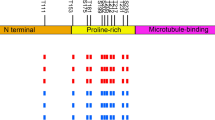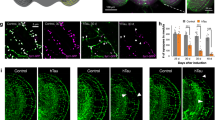Abstract
The tauopathies are a group of disorders characterised by aggregation of the microtubule-associated protein tau and include Alzheimer's disease (AD) and the fronto-temporal dementias (FTD). We have used Drosophila to analyse how tau abnormalities cause neurodegeneration. By selectively co-expressing wild-type human tau (0N3R isoform) and a GFP vesicle marker in motorneurons, we examined the consequences of tau overexpression on axonal transport in vivo. The results show that overexpression of tau disrupts axonal transport causing vesicle aggregation and this is associated with loss of locomotor function. All these effects occur without neuron death. Co-expression of constitutively active glycogen-synthase kinase-3β (GSK-3β) enhances and two GSK-3β inhibitors, lithium and AR-A014418, reverse both the axon transport and locomotor phenotypes, suggesting that the pathological effects of tau are phosphorylation dependent. These data show that tau abnormalities significantly disrupt neuronal function, in a phosphorylation-dependent manner, before the classical pathological hallmarks are evident and also suggest that the inhibition of GSK-3β might have potential therapeutic benefits in tauopathies.
This is a preview of subscription content, access via your institution
Access options
Subscribe to this journal
Receive 12 print issues and online access
$259.00 per year
only $21.58 per issue
Buy this article
- Purchase on Springer Link
- Instant access to full article PDF
Prices may be subject to local taxes which are calculated during checkout





Similar content being viewed by others
References
Heutink P . Untangling tau-related dementia. Hum Mol Genet 2000; 9: 979–986.
Williams DW, Tyrer M, Shepherd D . Tau and tau reporters disrupt central projections of sensory neurons in Drosophila. J Comp Neurol 2000; 428: 630–640.
Wittmann CW, Wszolek MF, Shulman JM, Salvaterra PM, Lewis J, Hutton M et al. Tauopathy in Drosophila: neurodegeneration without neurofibrillary tangles. Science 2001; 293: 711–714.
Jackson GR, Wiedau-Pazos M, Sang TK, Wagle N, Brown CA, Massachi S et al. Human wild-type tau interacts with wingless pathway components and produces neurofibrillary pathology in Drosophila. Neuron 2002; 34: 509–519.
Jancsik V, Filliol D, Rendon A . Tau proteins bind to kinesin and modulate its activation by microtubules. Neurobiology 1996; 4: 417–429.
Ebneth A, Godemann R, Stamer K, Illenberger S, Trinczek B, Mandelkow E . Overexpression of tau protein inhibits kinesin-dependent trafficking of vesicles, mitochondria, and endoplasmic reticulum: implications for Alzheimer's disease. J Cell Biol 1998; 143: 777–794.
Nuydens R, Van Den Kieboom G, Nolten C, Verhulst C, Van Osta P, Spittaels K et al. Coexpression of GSK-3beta corrects phenotypic aberrations of dorsal root ganglion cells, cultured from adult transgenic mice overexpressing human protein tau. Neurobiol Dis 2002; 9: 38–48.
Stamer K, Vogel R, Thies E, Mandelkow E, Mandelkow EM . Tau blocks traffic of organelles, neurofilaments, and APP vesicles in neurons and enhances oxidative stress. J Cell Biol 2002; 156: 1051–1063.
Gindhart Jr JG, Desai CJ, Beushausen S, Zinn K, Goldstein LS . Kinesin light chains are essential for axonal transport in Drosophila. J Cell Biol 1998; 141: 443–454.
Martin M, Iyadurai SJ, Gassman A, Gindhart Jr JG, Hays TS, Saxton WM . Cytoplasmic dynein, the dynactin complex, and kinesin are interdependent and essential for fast axonal transport. Mol Biol Cell 1999; 10: 3717–3728.
Bowman AB, Kamal A, Ritchings BW, Philp AV, McGrail M, Gindhart JG et al. Kinesin-dependent axonal transport is mediated by the sunday driver (SYD) protein. Cell 2000; 103: 583–594.
Bowman AB, Patel-King RS, Benashski SE, McCaffery JM, Goldstein LS, King SM . Drosophila roadblock and Chlamydomonas LC7: a conserved family of dynein-associated proteins involved in axonal transport, flagellar motility, and mitosis. J Cell Biol 1999; 146: 165–180.
Saxton WM, Hicks J, Goldstein LS, Raff EC . Kinesin heavy chain is essential for viability and neuromuscular functions in Drosophila, but mutants show no defects in mitosis. Cell 1991; 64: 1093–1102.
Hurd DD, Stern M, Saxton WM . Mutation of the axonal transport motor kinesin enhances paralytic and suppresses Shaker in Drosophila. Genetics 1996; 142: 195–204.
Williams DW, Shepherd D . Persistent larval sensory neurones are required for the normal development of the adult sensory afferent projections in Drosophila. Development 2002; 129: 617–624.
Feany MB, Bender WW . A Drosophila model of Parkinson's disease. Nature 2000; 404: 394–398.
Shepherd D, Block L, Folwell J, Williams DW . Studying cell interactions during development of the nervous system in Drosophila. In: Tom F (ed). Cell–Cell interactions. Oxford University Press: Oxford, 2002 pp 119–151.
Suster ML, Bate M . Embryonic assembly of a central pattern generator without sensory input. Nature 2002; 416: 174–178.
Klein PS, Melton DA . A molecular mechanism for the effect of lithium on development. Proc Natl Acad Sci USA 1996; 93: 8455–8459.
Trinczek B, Ebneth A, Mandelkow EM, Mandelkow E . Tau regulates the attachment/detachment but not the speed of motors in microtubule-dependent transport of single vesicles and organelles. J Cell Sci 1999; 112(Part 14): 2355–2367.
Ishihara T, Hong M, Zhang B, Nakagawa Y, Lee MK, Trojanowski JQ et al. Age-dependent emergence and progression of a tauopathy in transgenic mice overexpressing the shortest human tau isoform. Neuron 1999; 24: 751–762.
Probst A, Gotz J, Wiederhold KH, Tolnay M, Mistl C, Jaton AL et al. Axonopathy and amyotrophy in mice transgenic for human four-repeat tau protein. Acta Neuropathol (Berl) 2000; 99: 469–481.
Spittaels K, Van den Haute C, Van Dorpe J, Bruynseels K, Vandezande K, Laenen I et al. Prominent axonopathy in the brain and spinal cord of transgenic mice overexpressing four-repeat human tau protein. Am J Pathol 1999; 155: 2153–2165.
Khatoon S, Grundke-Iqbal I, Iqbal K . Brain levels of microtubule-associated protein tau are elevated in Alzheimer's disease: a radioimmuno-slot-blot assay for nanograms of the protein. J Neurochem 1992; 59: 750–753.
Su JH, Cummings BJ, Cotman CW . Early phosphorylation of tau in Alzheimer's disease occurs at Ser-202 and is preferentially located within neurites. Neuroreport 1994; 5: 2358–2362.
Spittaels K, Van den Haute C, Van Dorpe J, Geerts H, Mercken M, Bruynseels K et al. Glycogen synthase kinase-3beta phosphorylates protein tau and rescues the axonopathy in the central nervous system of human four-repeat tau transgenic mice. J Biol Chem 2000; 275: 41340–41349.
Lovestone S, Davis DR, Webster MT, Kaech S, Brion JP, Matus A et al. Lithium reduces tau phosphorylation: effects in living cells and in neurons at therapeutic concentrations. Biol Psychiatry 1999; 45: 995–1003.
Alonso AC, Zaidi T, Grundke-Iqbal I, Iqbal K . Role of abnormally phosphorylated tau in the breakdown of microtubules in Alzheimer disease. Proc Natl Acad Sci USA 1994; 91: 5562–5566.
Almenar-Queralt A, Goldstein LS . Linkers, packages and pathways: new concepts in axonal transport. Curr Opin Neurobiol 2001; 11: 550–557.
Goldstein LS . Kinesin molecular motors: transport pathways, receptors, and human disease. Proc Natl Acad Sci USA 2001; 98: 6999–7003.
Kamal A, Stokin GB, Yang Z, Xia CH, Goldstein LS . Axonal transport of amyloid precursor protein is mediated by direct binding to the kinesin light chain subunit of kinesin-I. Neuron 2000; 28: 449–459.
Kamal A, Almenar-Queralt A, LeBlanc JF, Roberts EA, Goldstein LS . Kinesin-mediated axonal transport of a membrane compartment containing beta-secretase and presenilin-1 requires APP. Nature 2001; 414: 643–648.
Torroja L, Chu H, Kotovsky I, White K . Neuronal overexpression of APPL, the Drosophila homologue of the amyloid precursor protein (APP), disrupts axonal transport. Curr Biol 1999; 9: 489–492.
Acknowledgements
This work was supported by the Alzheimer's Society and The Wellcome Trust. We would like to acknowledge Professor Hugh Perry and Dr Francis Chee for comments on the manuscript, and Dr Anton Page and Mr Roger Alston of the Biomedical Imaging Unit for confocal microscopy.
Author information
Authors and Affiliations
Corresponding author
Additional information
(Supplementary information accompanies the paper on Molecular Psychiatry website (http://www.nature.com/mp))
Rights and permissions
About this article
Cite this article
Mudher, A., Shepherd, D., Newman, T. et al. GSK-3β inhibition reverses axonal transport defects and behavioural phenotypes in Drosophila. Mol Psychiatry 9, 522–530 (2004). https://doi.org/10.1038/sj.mp.4001483
Received:
Revised:
Accepted:
Published:
Issue Date:
DOI: https://doi.org/10.1038/sj.mp.4001483
Keywords
This article is cited by
-
The Neurobiological Role of Lithium Salts
Neuroscience and Behavioral Physiology (2023)
-
Understanding Glycogen Synthase Kinase-3: A Novel Avenue for Alzheimer’s Disease
Molecular Neurobiology (2023)
-
Atypical, non-standard functions of the microtubule associated Tau protein
Acta Neuropathologica Communications (2017)
-
What is the evidence that tau pathology spreads through prion-like propagation?
Acta Neuropathologica Communications (2017)
-
Salidroside reduces tau hyperphosphorylation via up-regulating GSK-3β phosphorylation in a tau transgenic Drosophila model of Alzheimer’s disease
Translational Neurodegeneration (2016)



